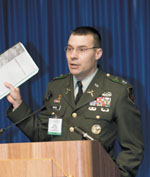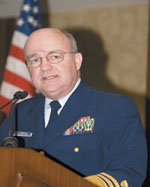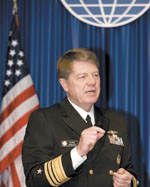Innovative Approaches Key to Warfighting, Military Posture
 |
| Former New York City Mayor Rudolph Giuliani gives the kickoff address at West 2007. |
Far-ranging discussions on these points were front and center at West 2007, the annual conference and exposition sponsored by AFCEA International and the U.S. Naval Institute. Held January 31-February 2 in San Diego, the event opened with a speech by the man whom many Americans associate with leadership under terrible duress in the Global War on Terrorism—former New York City Mayor Rudolph Giuliani. Mayor Giuliani’s kickoff speech launched the three-day conference, which was titled “Swords and Diplomacy: How Do We Build the Right Military to Fight, Win and Influence?”
Giuliani told a standing-room-only crowd that the Global War on Terrorism had been ongoing for many years prior to the September 11, 2001, attacks on his home city. The same enemy responsible for those attacks struck at the
Until the September 11 attacks, the West was entirely on the defensive, treating terrorism as a crime and reacting only symbolically—if at all—to terrorist acts. But after the
Giuliani addressed the Iraq War, saying that if the
Difficult endeavors require trial and error, he declared, and he warned against shying away from an effort just because it is difficult. One key quality of leadership is to have a set of beliefs or a plan. Another is to be optimistic and to think success. Many people who look at
That optimism is key because the terrorists hope to break the
 |
| Lt. Col. John Nagl, USA, the commanding officer of the 1st Battalion, 34th Armor Regiment, Fort Riley, holds up a counterinsurgency manual issued by the U.S. Army (FM 3-24) and the U.S. Marine Corps (MCWP 3-33.5). This manual, which was put together with input from many nontraditional sources, offers new tactics for dealing with the Iraqi insurgency. |
The
Key to defeating the insurgency is obtaining intelligence on the enemy, the colonel said. But another vital element is obtaining the support of the public at large. The insurgency knows this. Col. Nagl offered that the allies must target Americans and different segments of the Iraqi people with information operations, and he called for the re-establishment of the U.S. Information Agency in the form in which it operated during the Cold War, when it was highly effective.
Several audience members questioned whether the manual was comprehensive enough to be useful. One questioner pointed out that the manual lacked any substantive mention of potential enabling technologies. Col. Nagl explained that officials are at work on a revision that will take technologies into account, and he added that the application of technology to this problem is essential to success.
 |
| Adm. James G. Stavridis, USN, describes the varied hurdles that he faces as commander of the U.S. Southern Command. |
“Our operations are a balance between swords and diplomacy,” he stated.
The countries that constitute Central America and South America are not in the
The countries of the Caribbean and
Foremost among these is poverty. As much as 40 percent of the region’s populace lives on $1 a day. These countries with many poor also tend to have a wealthy segment that illustrates the extremes of their societies. And, many of these nations face transnational threats such as drug production and smuggling, terrorism, corruption, urban gangs and natural disasters.
The major danger involves narcotics, especially because 25,000 Americans die each year from drugs or drug-related activities. Interdicting drug flow is similar to antisubmarine warfare, the admiral pointed out. It involves finding a platform that does not want to be found.
Some of these challenges can be addressed by military-to-military contacts, the admiral observed. The 1,000-ship navy concept—in which allies network their navies to produce a giant ad hoc force—is “made for
However, the difficulties in implementing that concept elsewhere also plague SOUTHCOM. The
The command also needs language facility, the admiral offered. While waiting for artificial intelligence techniques to progress for broad translation capabilities, the admiral stated that his goal is for 70 percent of all operators to be able to speak either Spanish or Portuguese.
 |
| Vice Adm. Charles D. Wurster, USCG, discusses the Coast Guard’s multifaceted challenges and programs. |
“We’ve only scratched the surface of border security,” he declared.
Recent accomplishments include groundbreaking agreements with the U.S. Northern Command, a national maritime response plan and progress with the International Maritime Organization (IMO) on automated ship identification. But, much remains to be done, he cautioned, and many factors will affect
Maritime regimes, maritime domain awareness and maritime operations make up those factors. In the same manner that the U.S. Department of Homeland Security has its secure border initiative for land, Adm. Wurster called for a “secure border initiative–wet.” The nation needs a single credentialing system to serve as a screening tool for vessels entering
The Coast Guard is internationally involved both through global agreements and through bilateral pacts. The IMO recently established the protocols for 300-gross-ton ships to be identified at sea. Bilateral agreements with
The Coast Guard’s modernization efforts focus on a “strategic triad” of shore-based forces, mobile forces and deployable forces. The centerpiece is its Deepwater program, which Adm. Wurster described as “the eyes and ears” for the maritime domain. He conceded that the Coast Guard has had difficulty in getting the results it wants with that program, but the commandant is addressing the problem. This initiative takes the Coast Guard’s restructuring into account, he added.
If Deepwater is the Coast Guard’s eyes and ears out at sea, its command centers serve as the eyes and ears of
 |
| U.S. Defense Department information official David Wennergren outlines the department’s data strategy. |
As networks grew, their interrelationships and lines of access and connectivity often became so complex and convoluted that their form shapes could not be sustained. Instead of a Tinker toy nightmare, Wennergren offered, the new model should be that of a plasma ball—a single source of information that could be interconnected in any direction.
“The world is not about separate networks,” he said.
But many tasks must be accomplished to achieve this goal. Data must be available to be consumed in a standard way. Configuration management is vital for operators to know the system fully. The department still must weed its way through software to determine what it needs and what it doesn’t need.
Some recent measures have helped key aspects of information. Rationalizing networks, which helped configuration management greatly and saved money, additionally has aided infrastructure security measures. Information assurance also has been enabled by common access cards, the use of which has reduced the information security threat. Biometrics continues to be a growth area for the Defense Department, Wennergren added.
He called for an innovative partnership with industry. In this Web-based world, the department must align with standards and open architectures. For its strategic planning, it must accelerate the development of a network-centric culture. The department also must network the warfighter, make information a force multiplier, facilitate warfighter access to intelligence and secure the network.
“Everything’s going digital,” Wennergren declared. “It’s all about moving to the Web.”
 |
| Vice Adm. Mark J. Edwards, USN, deputy chief of naval operations for communication networks, N-6, gives a keynote address on new information technology initiatives for the U.S. Navy. |
Adm. Edwards showed a screenshot of a standard Navy online video that looked proper, well designed and unremarkable. About 300 people had viewed this video, he said. Then, right next to it, he presented a video that was put together by Navy personnel in carrier airborne early warning squadron VAW-116. Titled “Pump It,” the five-minute video set to rock music had been viewed on YouTube more than 400,000 times, and it had earned four stars from reviewers.
The admiral continued that the Navy has not kept pace with technology growth, but many of the people coming into the Navy have. Not only must the Navy tap their expertise, it also must create an environment in which they will flourish. The technology-savvy Millennium Generation, which comprises people younger than age 25, tends to focus on cutting-edge technology and collaboration. Those and other qualities of that generation are the N-6’s focus, he said.
The Navy is spending more money on information technology than industry, but it is not getting its money’s worth, the admiral charged. The leading causes of this shortfall are legacy systems and systems that do not give the Navy substantial payback, he added. It is imperative that the Navy closes the gap with industry in part by drawing solutions from industry.
While the early bird may get the worm, he observed, the Navy should apply a different animal analogy. “The second mouse gets the cheese,” he emphasized. “We want to be the second mouse and feed off of industry.”
The Navy is sorely lacking in sufficient bandwidth, and it must improve its networks to provide enough bandwidth with secure links to ensure effective operations, Adm. Edwards declared. Otherwise, the sea service will become the service-least-gone-to for commanding forces in the field. Without better information technology, the Navy may never become a joint task force commander, the admiral warned.
The first West 2007 panel dove into the Iraq War as it focused on operational lessons learned and solutions. Panel moderator Maj. Gen. David L. Grange, USA (Ret.), president and chief executive officer, McCormick Tribune Foundation, stated that the new troop surge may be the last chance for the
Col. Michael A. Shupp, USMC, chief of staff for the Joint IED Defeat Organization and a former commander of a Marine regimental combat team and a Marine regiment, related how Iraqi forces acquitted themselves well fighting alongside Marines. Stories of the Iraqis’ bravery have not been told here, he said.
Echoing Col. Shupp’s stories about Iraqi forces’ heroism, Col. Nagl described how finding the insurgents is harder than fighting them. The solution to defeating the insurgency is not more power but better intelligence, he offered.
Brig. Gen. (Sel.) Michael Callan, USAF, commander, Air Force Special Operations Forces, and director of operations, Air Force Special Operations Command, gave a U.S. Air Force perspective to the fight in
Cmdr. Steve Wisotzki, USN, chief of staff, Naval Special Warfare Group One, and the former commander of SEAL Team 1, outlined how Navy SEALs conducted operations in Al Anbar province, which he described as the most dangerous region in
But much of the panel’s discussion focused on the role and influence of the media in that conflict. A consensus seemed to emerge from all of the panelists that the news media largely has covered the war well from the battlefield.
Col. Shupp lauded the work of embedded media in covering the troops, although these reporters often share the military’s frustrations about how their stories are edited back home. Col. Nagl seconded his remarks, but Gen. Callan stated that not all reporting from the front has been good and that positive stories are not always being told back home.
Gen. Grange agreed that many reporters do not get to choose what is put on television or how their print stories are edited. He said that the television producers are the ones who decide how the field journalists’ reports are presented, if at all, and those producers may be acting on their own personal opinions.
An individual in the audience who described himself as a member of the media but did not identify himself took umbrage at Gen. Grange’s comments. He angrily condemned the general for accusing the media of bias, especially as so many reporters have given their lives covering the war. Gen. Grange apologized to the man for giving that impression, but he defended his statement that not all field reporters covering the Iraq War can control how their reportage is presented.
Cmdr. Wisotzki added that the
One panel focusing on the 1,000-ship navy concept turned into a lively discussion about whether the U.S. Navy could even sustain its shipbuilding. Noted author and panel moderator Norman Polmar warned that the
Lt. Col. Frank Hoffman, USMC (Ret.), a research fellow at the Center for Emerging Threats and Opportunities, bluntly stated that “tomorrow’s fleet is at risk.” The Navy may not be getting its fair share of defense funding for the long haul. The retired Marine lieutenant colonel offered that the 313-ship architecture may not be right for the Navy’s new strategy, which must include maritime security. He also called for increasing amphibious capabilities. All told, the Navy may require a $15 billion floor annually for shipbuilding, he added.
But Col. Hoffman’s bluntness was exceeded by the harsh admonishments of Eric J. Labs, senior analyst for naval forces and weapons at the Congressional Budget Office’s National Security Division. Labs painted a gloomy picture of Navy shipbuilding from both fiscal and logistical perspectives.
He called the goal of 313 ships by 2020 “disingenuous.” Two-thirds of that number already are in the fleet or are under construction. But even if the Navy could achieve its 313-ship goal, it couldn’t sustain it past 2027, he said. Surface combatants are being decommissioned faster than they are being replaced. And, by 2037 the number of ships in the fleet will be as small as it is today because some types of ships and submarines will leave the fleet without any replacements planned.
Labs went beyond Hoffman in criticizing the $11 billion annual shipbuilding budget. Even the Navy believes it will need an average of $16 billion each year over the next 30 years, he pointed out. But Labs believes a more accurate number is $21 billion annually over 30 years. That figure likely will be unsustainable as domestic federal spending on items such as Medicare explodes over the coming years.
“You will have a smaller, less capable fleet,” he declared.
 |
| A maritime strategy for the Asia-Pacific region was the topic of a panel featuring (l-r) Rear Adm. Michael McDevitt, USN (Ret.), director, Center for Strategic Studies, Center for Naval Analyses; Cdre. Jack McCaffrie, RANR, visiting fellow, Sea Power Centre; Lt. Gen. Wallace C. Gregson Jr., USMC (Ret.), former commander, U.S. Marine Forces Pacific; Rear Adm. Roger Girouard, CF, OMM, CD, commander, Maritime Forces Pacific (Canada); and panel moderator Capt. Peter Swartz, USN (Ret.), strategy and policy analyst, Center for Naval Analyses. |
Rear Adm. Roger Girouard, CF, OMM, CD, commander, Maritime Forces Pacific (
Adm. Girouard added that the concept of the 1,000-ship navy is not new, but its time is right in this new era. A window of opportunity exists to grow this 1,000-ship navy, he added, but the key issue is trust, not technology. Adm. Girouard noted that
The key objective for
Retention of good people is central to a strong military, but in times of war, it is hard to develop individuals when they are pulled in many different ways. A group of service leaders addressed this challenge in a panel called “Warfighters: How Do We Develop and Retain 21st Century Enlisted Leaders?”
The panel featured Master Chief Petty Officer of the Coast Guard Charles W. Bowen, USCG; Master Chief Petty Officer of the Navy Joe R. Campa, USN; and Sgt. Maj. R. D. Himsworth, USMC, with former Master Chief Petty Officer of the Coast Guard Vince Paton III, USCG (Ret.), as its moderator. The panelists discussed a number of relevant issues.
Eighty percent of the military today is enlisted. These individuals not only need a career path that offers training and advancement, but with changing roles brought about by war, their families also need additional support. Providing adequate bandwidth is one method that helps families communicate and allows sailors to take online courses at sea, but supplying that bandwidth remains difficult.
Issues of education and family are important, but the services also have to ensure that individuals have the moral compass to make correct decisions in often-stressful situations, the panelists said. Good leaders who can deliver the technology and instill the necessary core values and competencies are essential.
Photography by Michael Carpenter. Additional West 2007 photos.




Comments